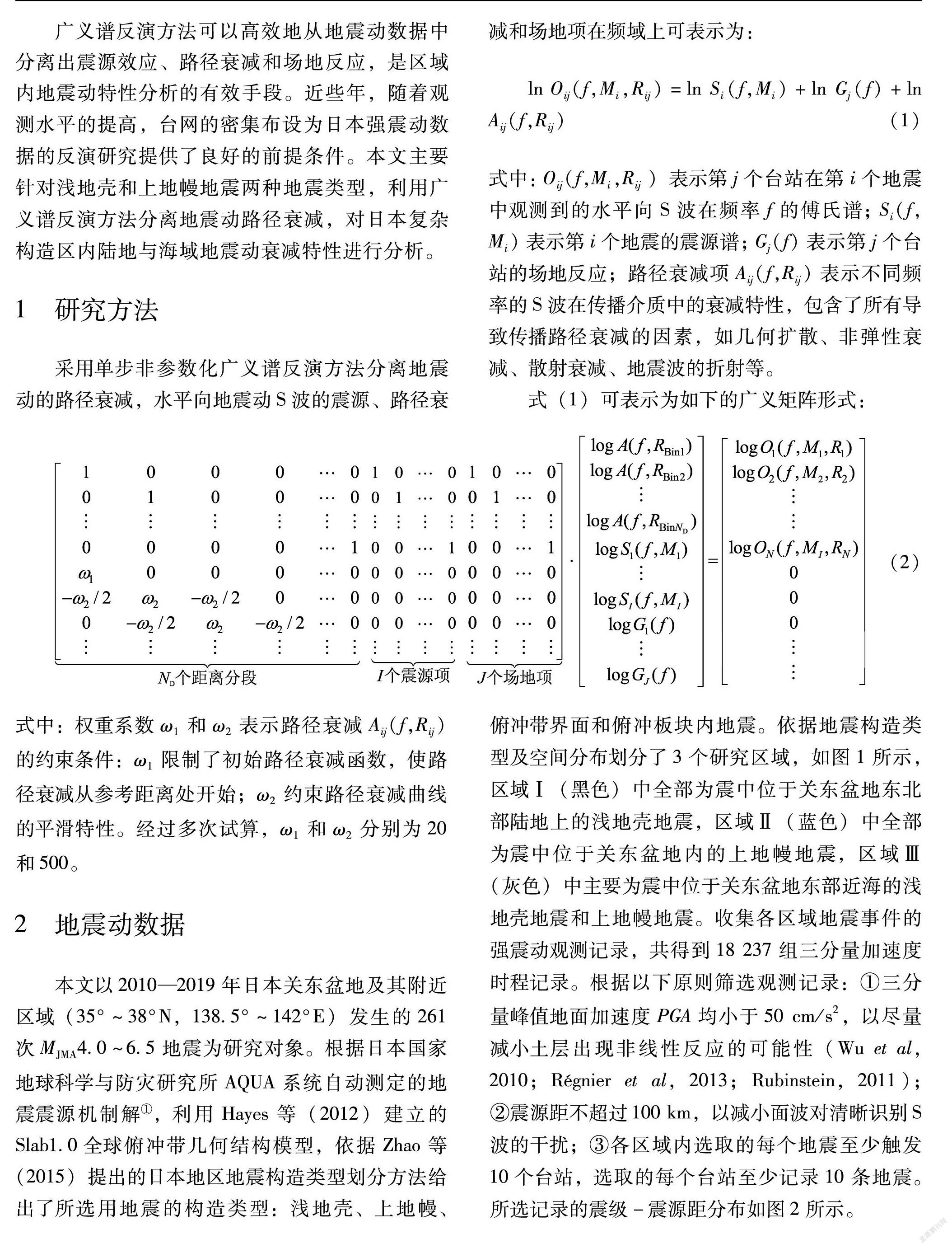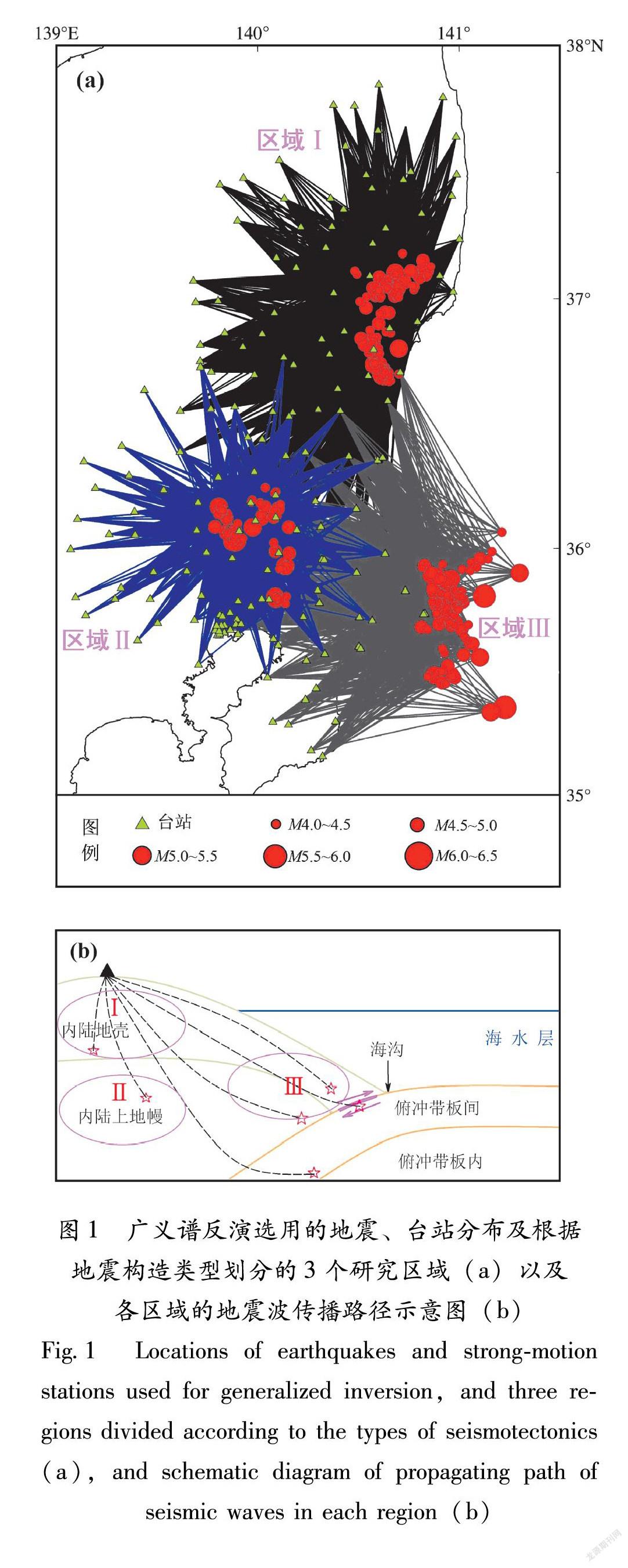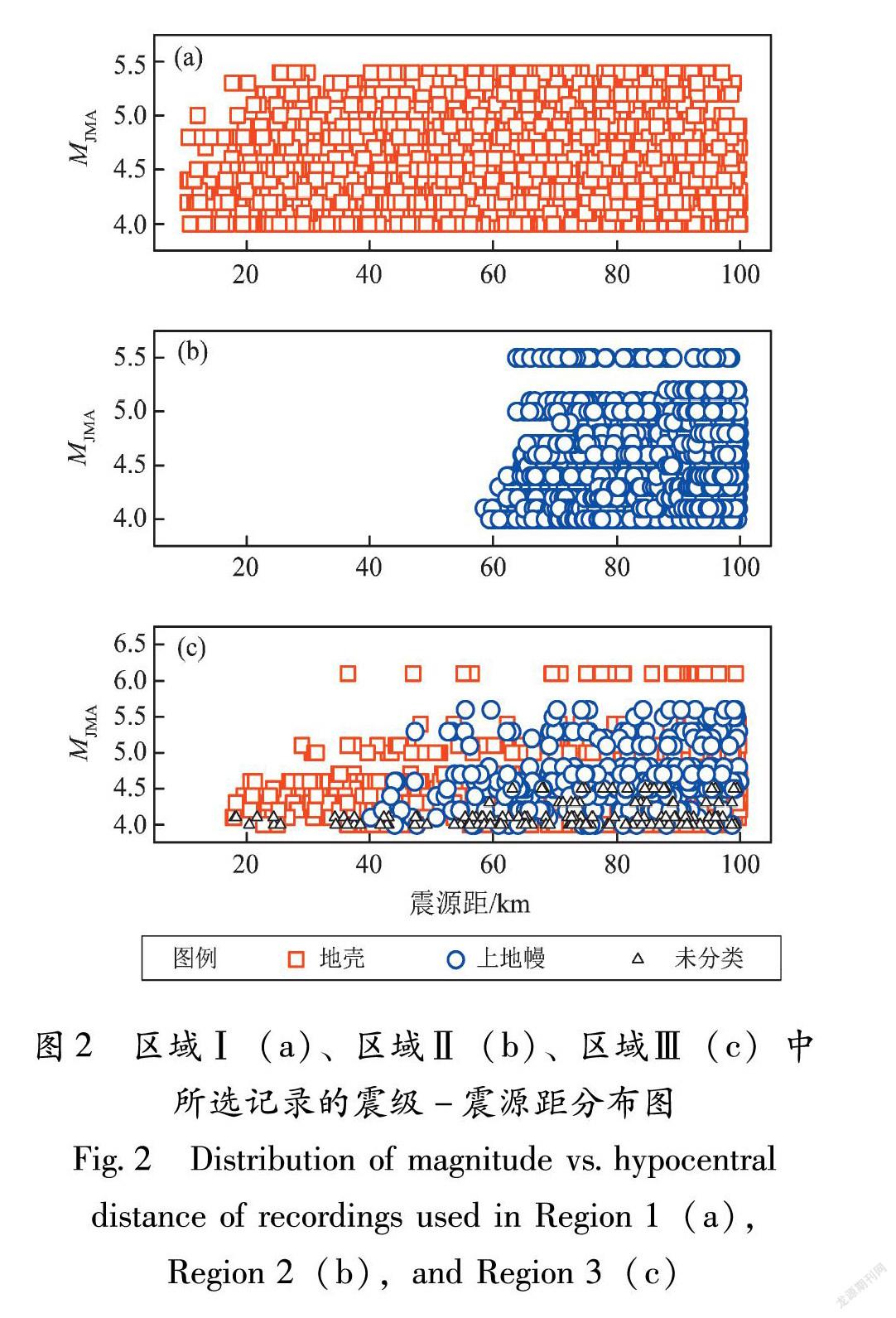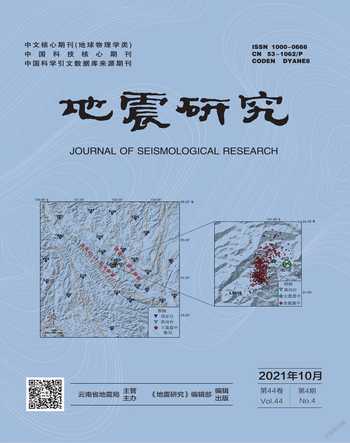基于广义反演方法的复杂板块构造下地震动衰减特性
2021-09-23周影王宏伟温瑞智
周影 王宏伟 温瑞智



摘要:为研究构造复杂的关东盆地及其周边地区的地震动衰减特性,根据地震震源机制解和Slab1.0模型,依据前人提出的日本地区地震构造类型划分方法给出所研究地震的构造类型,并依据地震构造类型及空间分布划分了3个研究区域。利用单步非参数化广义谱反演方法分析了3个区域的地震动衰减特性。结果表明:区域I中发生于陆地的浅地壳地震的地震动路径衰减较弱,远距离处近似不出现路径衰减,频率相关的非弹性衰减较弱,品质因子Q=92.33f;区域Ⅱ中,发生于陆地的上地幔地震的地震动路径衰减的下降速率随距离增大而增大,频率相关的非弹性衰减较强,Q=27.75f;区域Ⅲ中,发生于近海的浅层地壳和上地幔地震的地震动路径衰减兼具区域I、Ⅱ的衰减属性,Q=58.07f089。
关键词:广义谱反演方法;关东盆地;强地震动;衰减特性;品质因子
中图分类号:P315.914文献标识码:A文章编号:1000-0666(2021)04-0650-06
0引言
日本关东地区是日本人口数量最多且分布最密集的地区,也是地下构造最复杂的区域。欧亚大陆板块、菲律宾板块和太平洋板块自上至下形成了三层叠合的俯冲状态。菲律宾板块与欧亚大陆板块间的摩擦和扭转、太平洋板块与菲律宾板块的下沉挤压以及3个板块之间的应力不均匀分布导致许多地震的发生(Bilek,1998)。复杂的地质构造和频繁的地震活动导致关东地区地震危险性较高(Ishida ,1992;Sato et al ,2005),也使其成为研究复杂板块构造地震动衰减特征的理想位置。
地震动预测方程(GMPE)在地震工程、概率地震危险性分析以及结构抗震设计中发挥了重要作用,尤其在概率地震危险性分析中经常用到GMPE经验模型。近十几年,诸多GMPE模型被提出,包括被广泛使用的下一代衰减关系模型Abrahamson, Silva, 2008: Boore, Atkinson 2008; Campbell, Bozorgnia, 2008; Chiou Youngs ,2008)。但对俯冲带复杂板块区域的GMPE研究较少(Atkinson ,Boore,2003;MeVerry et al ,2006),且未将地震类别作为模型参数(Kanno et al ,2006;Zhao et al ,2006)。针对日本俯冲带的复杂构造,Zhao等(2015)将日本地震类型划分为4类:浅地壳、上地幔、俯冲界面和俯冲板块内地震,并提出了3类GMPE模型,分别针对俯冲板块内地震(Zhao et al ,2016a)、俯冲界面地震(Zhao et al ,2016b)、浅地壳和上地幔地震(Zhao et al ,2016c),结果发现:俯冲界面地震动非弹性衰减速率最快,但当周期大于3s后几乎不衰减;俯冲板块内地震动非弹性衰减速率最慢;上地幔地震动非弹性衰减速率始终高于浅地壳,但两者在长周期(T>2s)频段较为一致。
广义谱反演方法可以高效地从地震动数据中分离出震源效应、路径衰减和场地反应,是区域内地震动特性分析的有效手段。近些年,随着观测水平的提高,台网的密集布设为日本强震动数据的反演研究提供了良好的前提条件。本文主要针对浅地壳和上地幔地震两种地震类型,利用广义谱反演方法分离地震动路径衰减,对日本复杂构造区内陆地与海域地震动衰减特性进行分析。
1研究方法
采用单步非参数化广义谱反演方法分离地震動的路径衰减,水平向地震动S波的震源、路径衰减和场地项在频域上可表示为:
式中:O(f,M,R)表示第j个台站在第i个地震中观测到的水平向S波在频率f的傅氏谱;S(f,M)表示第i个地震的震源谱;G(f)表示第j个台站的场地反应;路径衰减项An(f,Rn)表示不同频率的S波在传播介质中的衰减特性,包含了所有导致传播路径衰减的因素,如几何扩散、非弹性衰减、散射衰减、地震波的折射等。
式(1)可表示为如下的广义矩阵形式:
式中:权重系数ω1和ω2表示路径衰减A(f,R)的约束条件:ω1限制了初始路径衰减函数,使路径衰减从参考距离处开始;ω2约束路径衰减曲线的平滑特性。经过多次试算,ω1和ω2分别为20和500。
2地震动数据
本文以2010—2019年日本关东盆地及其附近区域(35°~38°N,138.5°~142°E)发生的261次MJMA4.0~6.5地震为研究对象。根据日本国家地球科学与防灾研究所AQUA系统自动测定的地震震源机制解①,利用Hayes 等(2012)建立的Slab1.0全球俯冲带几何结构模型,依据Zhao等(2015)提出的日本地区地震构造类型划分方法给出了所选用地震的构造类型:浅地壳、上地幔、俯冲带界面和俯冲板块内地震。依据地震构造类型及空间分布划分了3个研究区域,如图1所示,区域I(黑色)中全部为震中位于关东盆地东北部陆地上的浅地壳地震,区域Ⅱ(蓝色)中全部为震中位于关东盆地内的上地幔地震,区域Ⅲ(灰色)中主要为震中位于关东盆地东部近海的浅地壳地震和上地幔地震。收集各区域地震事件的强震动观测记录,共得到18237组三分量加速度时程记录。根据以下原则筛选观测记录:①三分量峰值地面加速度PGA均小于50cm/s2,以尽量减小土层出现非线性反应的可能性(Wu et al ,2010; Regnier et al, 2013; Rubinstein, 2011)②震源距不超过100km,以减小面波对清晰识别S波的干扰;③各区域内选取的每个地震至少触发10个台站,选取的每个台站至少记录10条地震。所选记录的震级-震源距分布如图2所示。
区域I包含88个台站在98次MJMA4.0~5.4浅地壳地震中获得的4697组记录,震源深度主要分布在6~12km,最大不超过18km,记录主要体现了经过上地壳传播的直达地震波。区域Ⅱ包含79个台站在69次MJMA4.0~5.5上地幔地震中获得的2990组记录,震源深度在40~70km,最小震源距约为60km,记录主要体现了经过上地幔和地壳传播的直达地震波。区域Ⅲ包含52个台站在94次MMA4.0~6.2地震中获得的2109组记录,其中浅地壳和上地幔地震分别为64和21次,其余9个地震的构造类型不确定,震源深度分布在10~43km,多数地震为震源深度小于30km的浅地壳地震,最小震源距约为20km,记录体现了经过海域传播的上地幔和地壳的直达地震波。
對3个区域选取的强震动记录依次进行零线校正、记录首尾加余弦窗并补零、巴特沃斯非因果带通滤波处理选取,根据每条记录情况选择不同高通滤波截止频率,低通滤波截止频率统一为30Hz。利用Husid函数(Husid,1967)和能量法(Pacor et al ,2016)识别S波的到时和持时,截取记录S波窗,在S波窗首尾加余弦窗并补零后计算S波傅氏谱,进一步根据S波的信噪比(Oth et al ,2011a;Sharma et al ,2014)确定S波傅氏谱的有效频段。
3结果与讨论
3个区域的路径衰减曲线如图3所示,由图可见,各区域曲线差异明显,同时对比线性几何扩散衰减模型,包括R-05、R-1和R-3。区域I的路径衰减曲线的频率相关性不强,不同频率的路径衰减曲线差异不大,路径衰减曲线大致处于R-05和R-之间,整体上路径衰减较弱。震源距小于60km的路径衰减曲线整体上呈下降趋势,且随距离增大其下降速率更显著,但震源距大于60km的路径衰减曲线下降斜率出现拐折,衰减速率明显变小(图3a),这可能与壳幔边界的地震波折射有关。区域Ⅱ的路径衰减曲线仅体现了震源距60~100km的衰减,路径衰减曲线主要介于R-1和R-13之间。不同于区域Ⅰ的远场路径衰减,区域Ⅱ在远距离上的路径衰减更强烈,且随距离增大下降速率也增大,远距离处的路径衰减具有更强的频率相关(图3b),这与区域Ⅱ的深源上地幔地震并不存在壳幔边界的地震波折射有关。区域Ⅲ的路径衰减曲线介于R-和R-13之间,随距离增大路径衰减曲线(图3c)呈下降趋势,且随距离增大下降速率逐渐增大,不同频率的路径衰减曲线间的差异随距离增大而增大,远距离处的路径衰减频率相关性更明显(图3c),频率相关的路径衰减则说明了更强的非弹性衰减。
地震动的路径衰减可近似为用几何扩散GS和品质因子Q表示的非弹性衰减两部分,即:
式中:β为传播介质的剪切波速。
利用最小二乘法拟合得到不同频率的品质因子如图4所示,采用Q(f)=Qf的幂指数形式表示频率相关的品质因子,区域I、Ⅱ、Ⅲ的Q值分别表示为92.33f7、27.75f、58.07f。区域I、Ⅱ的Q值在低频段较为接近,这与Zhao等(2016a)得到的浅地壳地震与上地幔地震衰减速率在长周期(T>2s)频段较为一致的结果相符。区域Ⅱ、Ⅲ的Q值在高频段(f>10Hz)较为接近,说明高频段区域Ⅱ、Ⅲ的衰减函数曲线较为相似。区域I的Q值整体明显高于区域Ⅱ、Ⅲ。Tsuda 等(2010)利用发生于日本关东盆地附近的19个地震研究了盆地内的衰减特性与场地效应,得到的Q值为107f52。Nakano 等(2015)将日本地区划分为6个小区域分别给出了各小区域的S波品质因子,其中关东盆地及其东北部浅地壳地震的Q值为152.5f132。Oth等(2011b)将日本划分为6个小区域,其中关东盆地及东北部的浅地壳地震的S波Q值为(51±3)f(0.82±0.04)。Zhao等(2016a)指出日本上地幔的Q值普遍低于许多浅地壳的Q值,这与本文得到的结果一致。
4结论
本文依据地震构造类型及空间分布将地震构造复杂的关东盆地及其周边地区划分为3个区域,基于单步非参数化广义谱反演方法分析了研究区域的地震动衰减特性,得到主要结论如下:
(1)在区域I中,震中位于陆地的浅地壳地震的地震动路径衰减较弱,远距离处近似不出现路径衰减,频率相关的非弹性衰减较弱,品质因子Q=92.33fL.87。
(2)在区域Ⅱ中,震中位于陆地的上地幔地震的地震动路径衰减随距离增大始终呈下降趋势,路径衰减的下降速率随距离增大而增大,远场的路径衰减更强且频率相关性显著,频率相关的非弹性衰减较强,品质因子Q=27.75f1,明显小于浅地壳地震。
(3)在区域Ⅲ中,震中位于海域的浅地壳和上地幔地震的地震动路径衰减,既包含浅地壳地震较弱的路径衰减,也包含了上地幔地震的快速衰减特性,且传播路径与以上两区域都有部分重叠,数值介于两者之间,品质因子Q=58.07f
参考文献:
Abrahamson n. Silva w.2008. Summary of the Abrahamson silva NGA ground-motion relations[ J.Earthq. Spectra, 24(1): 67-97.
Atkinson G M, Boore D M.2003. Empirical ground - motion relations for subduction-zone earthquakes and their application to Caseadia and other regions [ J]. Bull Seismol Soc Am, 93(4): 1703-1729.
Bilek S L.1998. Variation of interplate fault zone properties with depth in the Japan subduction zoneL ]Seience 281(5380): 1175-1178.
Boore DM, Atkinson G M.2008. Ground- motion prediction equations for the average horizontal component of PGA, PGV, and 5% o damped PSA at spectral periods between 0.01 s and 10.0s[ J].Earthq Spectra ,24(1):99-138.
Campbell Kw, Bozorgnia Y.2008. NGA ground motion model for the geo-metrie mean horizontal component of PGA, PGV, PGD and 5%o damped linear elastic response spectra for periods ranging from 0. o1 to 10 s[ J].Earthq Spectra, 24(1): 139-171.
Chiou b s.youngsrr.2008. An nga model for the average of horizon-tal component of peak ground motion and response spectra [ J]Earthq Spectra, 24(1): 173-216.
Hayes GP, Wald D J, Johnson R L.2012. Slabl.0: A three dimensional model of global subduction zone geometries[ J. J Geophys Res, 117(B01302):1-15.
Husid R.1967. Gravity effects on the earthquake response of yielding structures. Report of Earthquake Engineering Research Laboratory Pasadena, California[ D]. Pasadena: California Institute of Technolo-8y.
Ishida M.1992. Geometry and relative motion of the Philippine Sea Plate and Pacifie Plate beneath the Kanto - Tokai distriet, Japan [ J]JGeophys Res, 97:489-513.
Kanno t.narita a.morikawa n. et a.2006. a new attenuation relation for strong ground motion in Japan based on recorded data[ J]. Bull Seis-mol Soe Am ,96(3):879-897.
MeVerry GH, Zhao Jx, Abrahamson NA, et al.2006. Crustal and sub-duction zone attenuation relations for New Zealand earthquakes[Bull New Zeal SoeEarthg Eng.39(1): 1-58.
Nakano K, Kawase H, Matsushima S.2015. Statistical properties of strong ground motions from the generalized spectral inversion of data ob-served by K-NET, Kik - net, and the JMashindokei network in Japan J]. Bull Seismol Soc Am, 105(5): 2662-2680.
Oth A, Parolai s, Bindi D, et al.2011a. Spectral analysis of K-NET and KiK-net data in Japan, part i: database compilation and peculiari-ties[ J]. Bull SeismolSoe Am, 101(2): 652-666
Oth A, Bindi D, Parolai s, et al.2011b. Spectral analysis of K-NET and KiK-net data in Japan, part ii: on attenuation characteristics, source spectra, and site response of borehole and surface stations[J].BullSeismolSoe Am, 101(2): 667-687.
Pacor F, Spallarossa D, Oth A, et al.2016.Spectral models for ground mo-tion prediction in the LAaquila region central Italy ) evidence for stress-drop dependence on magnitude and depth[ J.Geophys J Int,204:697-718.
Rubinstein JL.2011. Nonlinear site response in medium magnitude earth-quakes near Parkfield, California [ J]. Bull SeismolSoe Am,101(1):275-286.
Regnier J, Cadet H, Bonilla L F, et al.2013. Assessing nonlinear behavior of soils in seismic site response: Statistical analysis on KiK-net strong-motion data[ J]. Bull SeismolSoe Am, 103(3): 1750-1770
Sato H, Hirata N, Koketsu K, el al.2005. Earthquake source fault beneath Tokyo[ J]. Science, 309:462-464
Sharma J, Chopra S, Roy K S.2014. Estimation of source parameters quality factor( QS) , and site characteristies using accelerograms: Utt-arakhand Himalaya Region[ J]. Bull SeismolSoe Am, 104(1): 360-380.
Tsuda K.Koketsu K. Hisada Y. et al.2010. Inversion analysis of site re-sponses in the kanto basin using data from a dense strong motion seismograph array [ J]. Bull SeismolSoe of Am, 100(3): 1276-1287.
WuCQ, PengZG, Ben ZY.2010. Refined thresholds for non - linear ground motion and temporal changes of site response associated with medium-size earthquakes[].Geophys J Int, 182:1567-1576
Zhao JX, Jiang F, Shi P, et al.2016a. Ground-motion prediction equa-tions for subduetion slab earthquakes in Japan using site class and simple geometrie attenuation funetions [ J]. Bull SeismolSoe Am 106(4):1535-1551.
ZhaoJX, Liang X, Jiang F, et al.2016b. Ground motion prediction e-quations for subduction interface earthquakes in Japan using site class and simple geometrie attenuation functions [ J]. Bull SeismolSoe Am ,106(4):1518-1534.
Zhao x. Zhang J. Asano A. et a.2006. Attenuation relations of strong ground motion in Japan using site classification based on predomi-nantperiod[ J]. Bull SeismolSoe Am, 96(3):898-913
ZhaoJx, Zhou SL, Gao PJ, et al.2015. An earthquake classification scheme adapted for japan determined by the goodness of fit for ground-motion prediction equations [ J]. Bull SeismolSoe Am,105(5):2750-2763.
ZhaoJx, Zhou SL, Gao PJ, et al.2016e. Ground-motion prediction e-quations for shallow crustal and upper mantle earthquakes in Japan using site class and simple geometrie attenuation functions [ J. Bull SeismolSoe Am ,106(4):1552-1569.
Study of Attenuation Characteristics of the Complex Tectonic Region Based on Generalized Inversion Method
ZHOU Ying.2. WANG Hongwei.2. WEN Ruizhi.2
(1. Institute of Engineering Mechanics, China Earthquake Admninistration Harbin 150080, Heilongjiang China)
(2. Key Laboratory of earthquake Engineering and Engineering Vibration of China Earthquake Administration, Harbin 150080, Heilongjiang China)
Abstract
In order to study the characteristics of the ground motion attenuation of the complex plate tectonics of the Kanto basin and its vicinity in Japan, on the basis of the focal mechanism and Slabl.0 model, and according to the earthquake classification scheme adapted for Japan proposed by previous studies, we decided the categories of the earthquake events, and on this basis we further divided the study region into three parts. Then we used the method of One-step Nonparametric Generalized Spectrum Inversion to analyze the attenuation characteristics of ground vi-brations in the three regions. The results show that in Region I, the path attenuation of the ground motion of the shallow-crust earthquakes occurring inland is weak; there is almost no attenuation in long distance. The frequency dependent inelastic attenuation is also weak. The quality factor Q=92.33f0. In Region 2, the decay rate of the path attenuation of the upper-mantle earthquake inland increases with the increase of distance. The frequeney dependent inelastic attenuation is stronger. The quality factor =27.75f. In Region 3, the path attenuation of the ground motion of the shallow - crust and upper-mantle earthquakes in the offshore area has the same attributes of the path attenuation in the first two regions. The quality factor Q=58.07f
Keywords: Generalized Spectral Inversion method; the Kanto basin; strong ground motion; attenuation characteristics; quality factor
